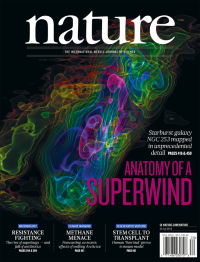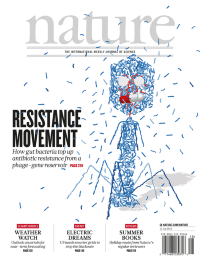Volume 499
-
No. 7459 25 July 2013
This three-dimensional isosurface rendering of the distribution of carbon monoxide emission in the nearby starburst galaxy NGC 253, imaged by the ALMA radio telescope, shows the filaments of a cool molecular wind in position-position-velocity space. Colour corresponds to the intensity of emission from red (faint) to blue-purple (bright). New interferometric observations that reveal the central two kiloparsec region of NGC 253 in unprecedented detail make it possible to measure the mass-outflow rate of the starburst system for the first time. By ejecting around nine solar masses per year (three times the mass converted to stars in the same period), the starburst-driven superwind� limits the star formation rate and the number of stars produced in this galaxy. Cover: Erik Rosolowsky
-
No. 7458 18 July 2013
Naked mole rats are remarkable in combining extreme longevity with virtually complete resistance to cancer. Now a novel glycosaminoglycan variant that may have evolved to provide the creatures with the tough, flexible skin needed for a subterranean lifestyle has been identified as a key contributor to their cancer resistance. Hyaluronan, or hyaluronic acid, is a ubiquitous component of the extracellular matrix. Xiao Tian et al. observed that the culture media of naked mole-rat fibroblasts becomes viscous owing to the accumulation of a thick gooey substance and identified it as a high-molecular-mass hyaluronan (HMM-HA), more than five times larger than mouse and human equivalents. It accumulates in naked mole-rat tissues owing to low hyaluronidase activity and a unique form of hyaluronan synthase 2. HMM-HA acts through the CD44 receptor and removal of HMM-HA makes naked mole-rat cells more susceptible to transformation. This unusual model of cancer protection suggests potential new avenues of research into anticancer and life-extension strategies. Cover: Joel Sartore/National Geographic Image Collection/Alamy
-
No. 7456 4 July 2013
The most heavily cratered terrains on Mercury exhibit a lower density of craters smaller than about 100 km in diameter than on the Moon, a deficit that has been attributed to resurfacing by formation of ancient intercrater plains. Simone Marchi et al. used a crater areal density map based on data from the MESSENGER spacecraft (the colour-coded foreground on cover, with a global surface mosaic in the background) to locate the oldest surfaces on Mercury and interpret the crater populations in the framework of a recent lunar crater chronology. They conclude that the oldest surfaces were emplaced just after the start of the Late Heavy Bombardment 4.0 to 4.1 billion years ago. The large impact basins, not previously dated, yield a similar surface age. This agreement implies that resurfacing was global and due to volcanism, perhaps aided by heavy bombardment as previously suggested. Cover: Simone Marchi/MESSENGER data: NASA/JHUAPL/Carnegie Institution of Washington




